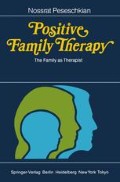Abstract
In order to understand human conflicts, we inquire about the contents carried out by them. In the psychosocial realm, these contents are not static, but develop their own dynamics. They are most clearly evident in our relationships with the people who are important to us: our parents, grandparents, siblings, spouses, children, and others. The arising conflicts are played out on many levels at the same time: in the way we deal with experiences and in our relationships with our partners, our family, and larger social groups. To do justice to these various aspects, the contents with which we describe such conflicts must appear in these relational levels.
The nephew of the ruler Ghabus-Woschmgir was seriously ill. All the physicians in the land had already given up hope. Their medicines had been to no avail. Since there was nothing more that the doctors could do, the ruler agreed that Avicena, who was a young man of sixteen at the time, should take over the treatment. When Avicena entered the palace, all were amazed at his courage, for he was determined to help the ailing man, even though all the wise hakims in the land had admitted their helplessness.
Avicena saw the ailing man, a thin, pale young man, stretched out on his bed. The man gave no reply to questions about his medical condition, and his relatives reported that he had not uttered a word for some time. Avicena took the man’s pulse and held his hand for a long time. Finally he raised his head thoughtfully and said, “This young man needs a different kind of treatment. To provide that, I need someone who really knows this city, someone who knows all its streets and alleys, all the houses, and all the people living in them.” All the people were amazed and asked, “What does healing a sick man have to do with the alleys of our city?” But in spite of their doubts, they obeyed Avicena’s command and sent for a man who, so it was said, knew the city like the palm of his hand. Avicena said to him, “Name all the sections of the town for me.” At the same time, he again took the patient’s pulse.
When a certain quarter of the city was mentioned, Avicena felt the man’s pulse quicken. Then he asked for the names of all the streets in that quarter, until the sick man’s pulse again quickened at the sound of a particular street name. Now Avicena asked for the names of the alleys that ran into that street. The man was naming them one by one, when suddenly the name of a small, little-known alley produced a much greater response in the ailing man. Pleased with this response, Avicena commanded, “Bring me a man who can name all the houses in this alley, along with the people living in them.” When they brought such a man to Avicena, he had him name all the houses, ancl the sick man’s pulse rate revealed which one Avicena was after.
When the man came to the names of the people living in that house, he also mentioned the name of a young woman. Immediately the patient’s pulse began to race. The observant Avicena commented, “Very good. Everything is clear. I now know the young man’s illness, and the cure is very simple.” He got up and spoke to the people, all of whom were staring at him in amazement. “This young man is suffering from lovesickness. This is the root of his physical ailment. He is in love with the girl whose name you just heard. Go get the girl and woo her as a bride.”
The patient who had listened to Avicena’s words with great attention and excitement, blushed with embarrassment and crawled under the covers. The ruler proclaimed the girl as his nephew’s bride, and the young man recovered within the hour.
—after Mowlana, Persian poet
Access this chapter
Tax calculation will be finalised at checkout
Purchases are for personal use only
Preview
Unable to display preview. Download preview PDF.
Author information
Authors and Affiliations
Rights and permissions
Copyright information
© 1986 Springer-Verlag Berlin Heidelberg
About this chapter
Cite this chapter
Peseschkian, N. (1986). Four Forms of Dealing with Conflict and How They Work. In: Positive Family Therapy. Springer, Berlin, Heidelberg. https://doi.org/10.1007/978-3-642-70680-6_32
Download citation
DOI: https://doi.org/10.1007/978-3-642-70680-6_32
Publisher Name: Springer, Berlin, Heidelberg
Print ISBN: 978-3-540-15768-7
Online ISBN: 978-3-642-70680-6
eBook Packages: Springer Book Archive

